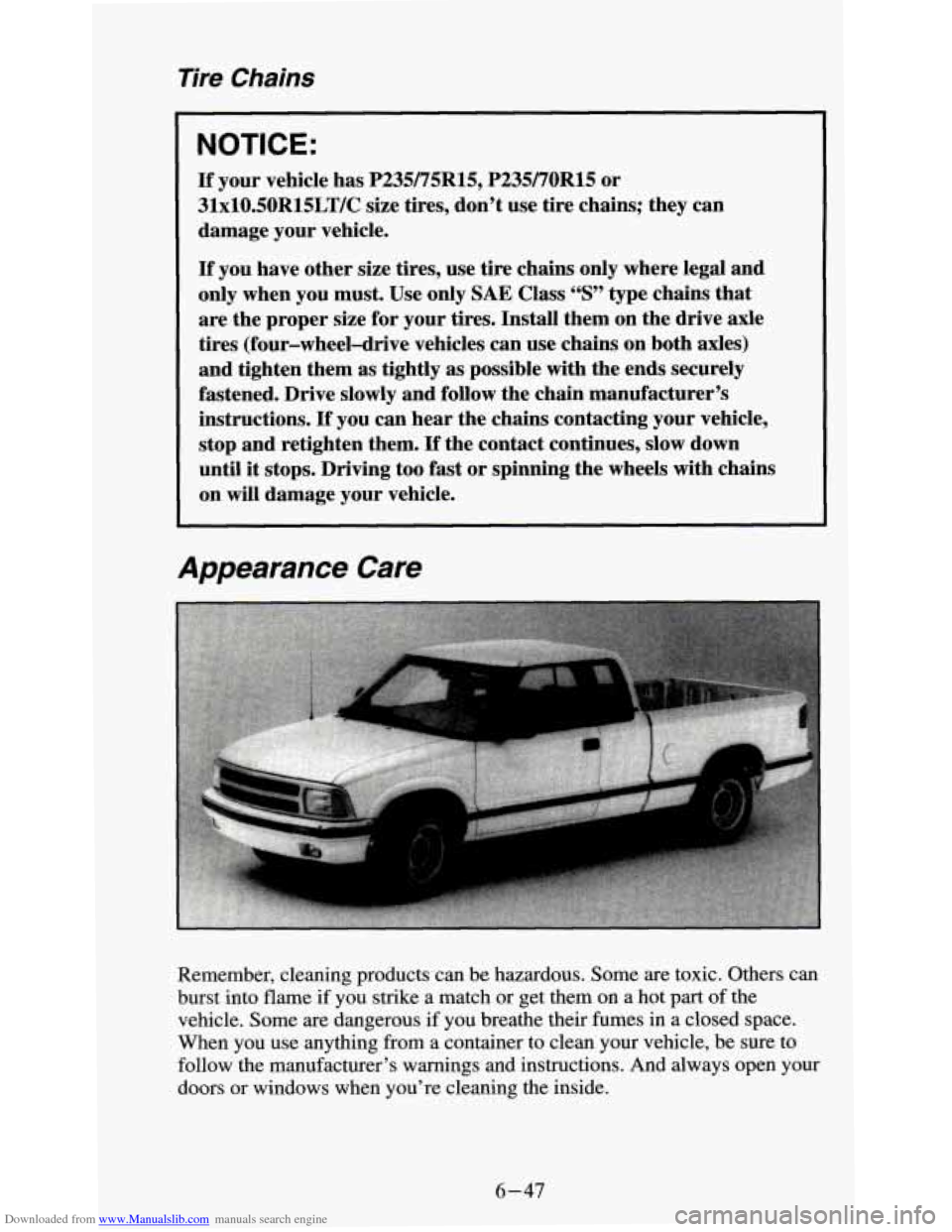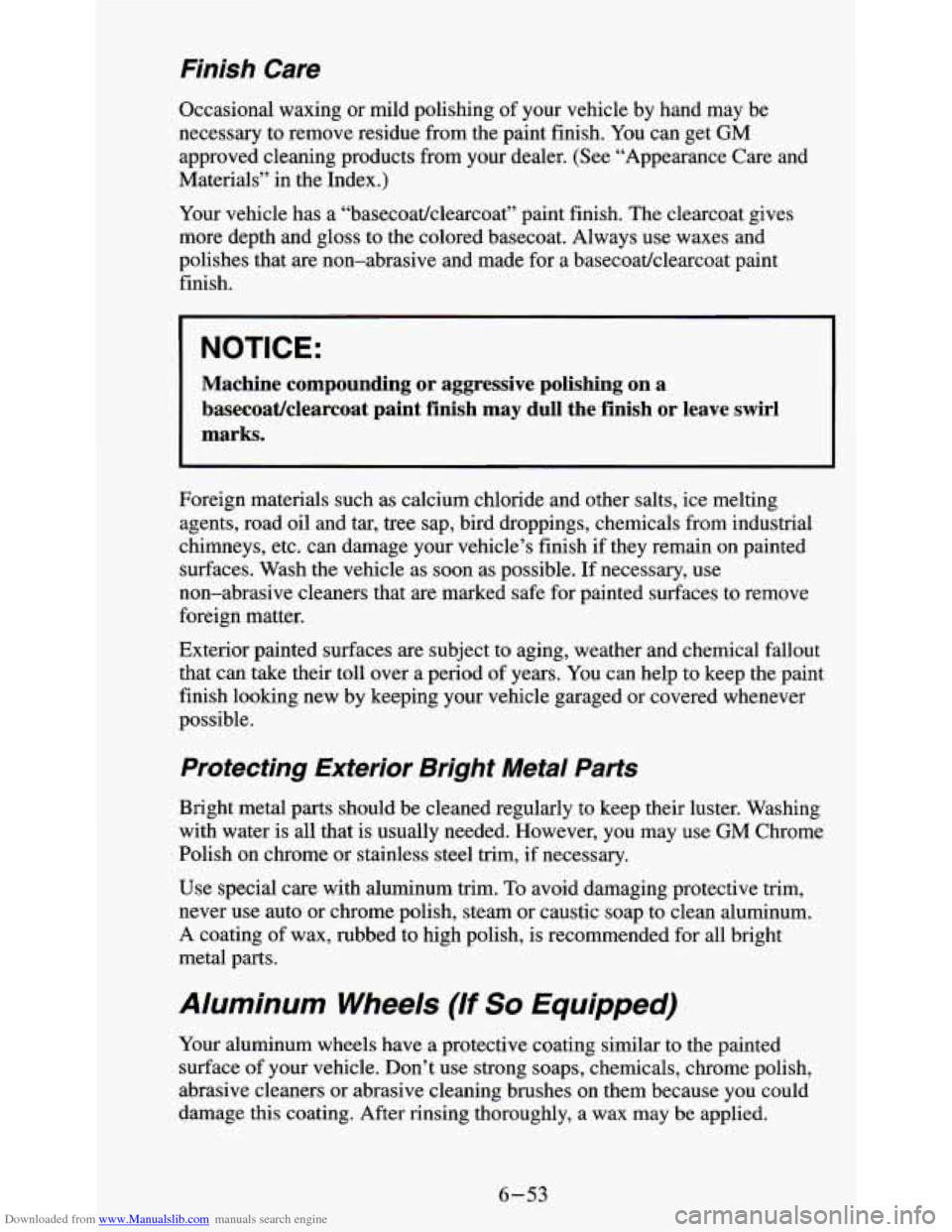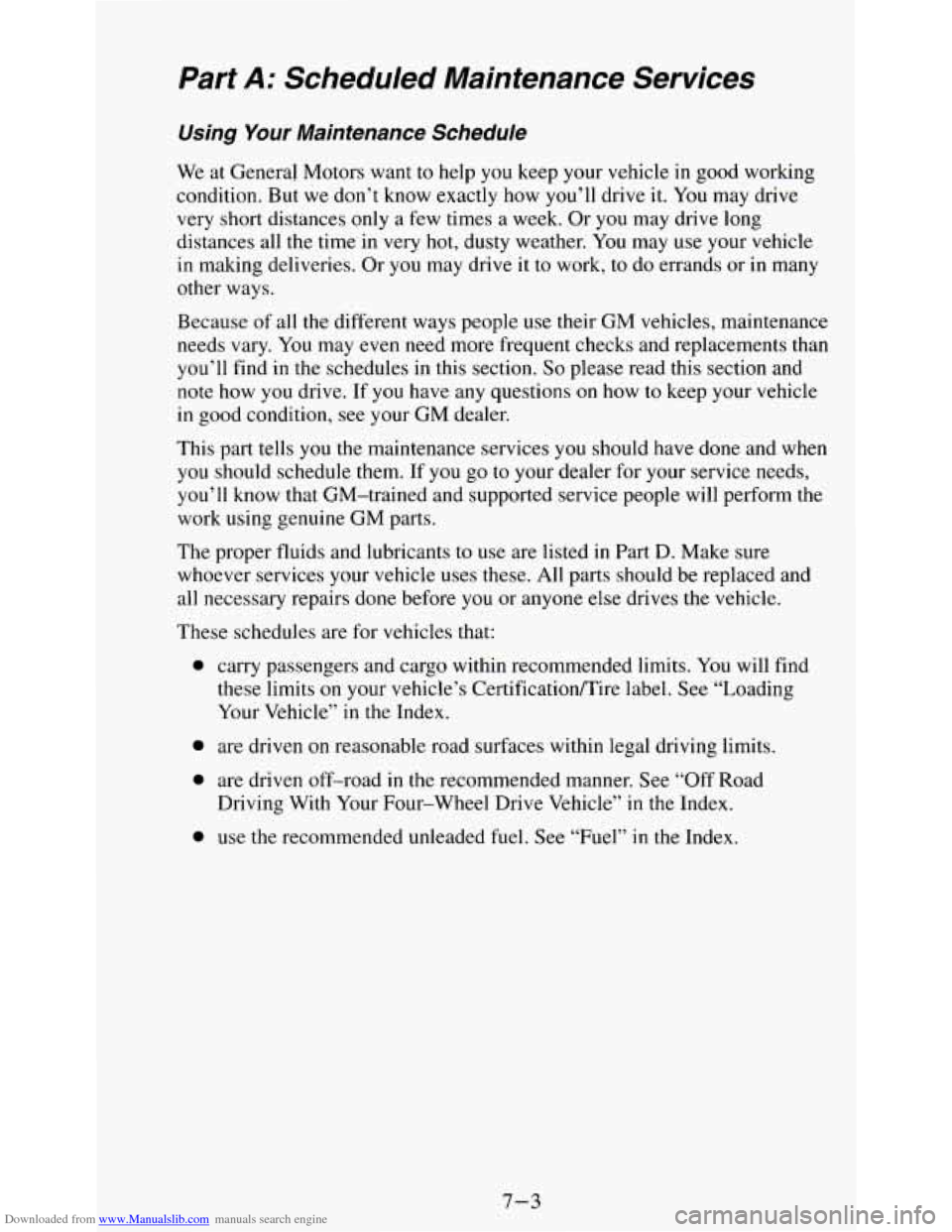Page 264 of 354

Downloaded from www.Manualslib.com manuals search engine Tire Chains
NOTICE:
If your vehicle has P235/75R15, P235/70R15 or
3lxl0.50R15LT/C size tires, don’t use tire chains; they can
damage your vehicle.
If you have other size tires, use tire chains only where legal and
only when you must. Use only
SAE Class “S” type chains that
are the proper size for your tires. Install them on the drive axle
tires (four-wheel-drive vehicles can use chains on both axles)
and tighten them
as tightly as possible with the ends securely
fastened. Drive slowly and follow the chain manufacturer’s
instructions.
If you can hear the chains contacting your vehicle,
stop and retighten them.
If the contact continues, slow down
until
it stops. Driving too fast or spinning the wheels with chains
on will damage your vehicle.
Appearance Care
Remember, cleaning products can be hazardous. Some are toxic. Others can
burst into flame if you strike
a match or get them on a hot part of the
vehicle. Some are dangerous if you breathe their fumes in a closed space.
When
you use anything from a container to clean your vehicle, be sure to
follow the manufacturer’s warnings and instructions. And always open your
doors
or windows when you’re cleaning the inside.
6-47
Page 270 of 354

Downloaded from www.Manualslib.com manuals search engine Finish Care
Occasional waxing or mild polishing of your vehicle by hand may be
necessary to remove residue from the paint finish. You can get
GM
approved cleaning products from your dealer. (See “Appearance Care and
Materials” in the Index.)
Your vehicle has a “basecoat/clearcoat” paint finish. The clearcoat gives
more depth and gloss to the colored basecoat. Always use waxes and
polishes that are non-abrasive and made for a basecoatklearcoat paint
finish.
NOTICE:
Machine compounding or aggressive polishing on a
I
basecoatklearcoat paint finish may dull the finish or leave swirl
marks.
Foreign materials such as calcium chloride and other salts, ice melting
agents, road oil and tar, tree sap, bird droppings, chemicals from industrial
chimneys, etc. can damage your vehicle’s finish if they remain on painted
surfaces. Wash the vehicle as soon as possible. If necessary, use
non-abrasive cleaners that
are marked safe for painted surfaces to remove
foreign matter.
Exterior painted surfaces are subject to aging, weather and chemical fallout
that can take their toll over a period of years.
You can help to keep the paint
finish looking
new by keeping your vehicle garaged or covered whenever
possible.
Protecting Exterior Bright Metal Parts
Bright metal parts should be cleaned regularly to keep their luster. Washing
with water is all that is usually needed. However, you may use
GM Chrome
Polish on chrome or stainless steel trim, if necessary.
Use special care with aluminum trim.
To avoid damaging protective trim,
never use auto or chrome polish, steam or caustic soap to clean aluminum.
A coating
of wax, rubbed to high polish, is recommended for all bright
metal parts.
Aluminum Wheels (If So Equipped)
Your aluminum wheels have a protective coating similar to the painted
surface of your vehicle. Don’t use strong soaps, chemicals, chrome polish,
abrasive cleaners or abrasive cleaning brushes on them because you could
damage
this coating. After rinsing thoroughly, a wax may be applied.
6-53
Page 271 of 354

Downloaded from www.Manualslib.com manuals search engine NOTICE:
If you have aluminum wheels, don’t use an automatic vehicle
wash that has hard silicon carbide cleaning brushes. These
brushes can take the protective coating
off your aluminum
wheels.
Tires
To clean your tires, use a stiff brush with a tire cleaner.
When applying a tire dressing always take care to wipe
off any overspray or
splash from painted surfaces. Petroleum-based products may damage the
paint finish.
Sheet Metal Damage
If your vehicle is damaged and requires sheet metal repair or replacement,
make sure the body repair shop applies anti-corrosion material to the parts
repaired or replaced to restore corrosion protection.
Foreign Material
Calcium chloride and other salts, ice melting agents, road oil and tar, tree
sap, bird droppings, chemicals from industrial chimneys, and other foreign
matter can damage your vehicle’s finish if they remain on painted surfaces.
Use cleaners that are marked safe for painted surfaces to remove foreign
matter.
Finish Damage
Any stone chips, fractures or deep scratches in the finish should be repaired
right away. Bare metal will corrode quickly and may develop into a major
repair expense.
Minor chips and scratches can be repaired with touch-up materials available
from your dealer or other service outlets. Larger areas of finish damage can
be corrected in your dealer’s body and paint shop.
6-54
Page 279 of 354
Downloaded from www.Manualslib.com manuals search engine Wheel Nut Torque
DESCRIPTION
Base or Optional Wheel
Cooling System Capacity
ENGINE
2.2L
4.3L
4.3L
VIN
4
Z
w
TORQUE
95 ft. lbs. (130 Nom)
QUANTITY*
11.5 Quarts (1 1 Liters)
12.1 Quarts (1 1.5 Liters)
12.1 Quarts
(1 1.5 Liters)
*All quantities are approximate. After refill, the level
MUST be rechecked.
Crankcase Capacity
ENGINE
2.2L
4.3L
4.3L
VIN CODE
4
z
W
QUANTITY WITH
FILTER*
4.5 Quarts (4.3 Liters)
4.5 Quarts (4.3 Liters)
4.5 Quarts (4.3 Liters)
*All quantities are approximate. After refill, the level
MUST be rechecked.
Fuel Tank Capacity
TYPE
Standard Tank
QUANTITY*
20 Gallons (76 Liters)
*All quantities are approximate.
6-62
Page 280 of 354
Downloaded from www.Manualslib.com manuals search engine Lamp and Bulb Data
LAMPS
EXTERIOR
QUANTITY TRADE NO.
2 2El
Halogen Headlamps -
Sealed Beam
Halogen Headlamps
-
Composite 2
9006 HB4 (Low Beam)
2
Halogen Headlamps
-
Composite
Backup Lamp
License Lamp
(w/o
Bumper) 9005
HB3
(High Beam)
3057 2
2 194
2 194
License Lamp (Step
Bumper)
Tail and Stop Lamps
Marker Lamp-Front
Marker Lamp-Rear
3057
194
194
3 157NA
2
Parking and Signal
Lamp
93
211-2
See GM Dealer
Underhood
Lamp
CHMSL
Fog Lamp
INTERIOR
Ash Tray Lamp
Courtesy Lamp
Dome Lamp 1
2 161
906
1 2 12-2
Four-wheel Drive Indicator
6 161
3
1
37
1003
Heater & A/C Control
Glovebox
Compartment Lamp
2 2 12-2
Rearview Mirror
Lamps
Sunshade Vanity
Mirror Lamps 4
74
6-63
Page 284 of 354
Downloaded from www.Manualslib.com manuals search engine NAME
GAUGES
ENG I
HTR A/C
PWR AUX
RR DEFOG
ECM BATT
ECM IGN
CIRCUITS PROTECTED
Alternator Field, VTC, A/C Compressor Relay, Cluster
Chime Module, DRL Relay Coil, Four-wheel Drive
Indictor Lamp, DRL Module, Rear Defog Timer, TCCM
Ignition, SIR Redundant Ignition, RKE Ignition
02 Sensor Heat Dr, EGR, Cam Sensor, CANN, Purge
Heater-A/C Blower Motor, Temperature Door Motor,
A/C Compressor Clutch, HI Blower Relay Coil, Timer
Relay Coil
Power Auxiliary Outlets, ALDL
Rear Window Defogger
PCMNCM Battery, ABS Battery (LN2), Fuel Pump
PCM/VCM Ignition, Injectors, Crank Sensor, Coil
Driver Module
6-67
Page 285 of 354
Downloaded from www.Manualslib.com manuals search engine NAME
RADIO
RDO BATT
ILLUM
DRL
TURN-B/U
CIRCUITS PROTECTED
Radio, Inside Rearview Mirror Map Lamp, Overhead
Console Reading Lamps, Rear Wiper, Rear Washer,
Overhead Console Display
Clock, Radio Battery, CD Player
Cluster Illumination, Ash Tray Lamp, Radio
Illumination, Heater Lamp, Four-wheel Drive
Illumination, Chime Module, Fog Lamp Illumination,
Rear Wiper Switch, Rear Defog Switch Illumination,
Lift Glass Release Switch Illumination, Overhead
Console Illumination
Daytime Running Lamps
Turn Signal and Back-up Lamps
6-68
Page 290 of 354

Downloaded from www.Manualslib.com manuals search engine Part A: Scheduled Maintenance Services
Using Your Maintenance Schedule
We at General Motors want to help you keep your vehicle in good working
condition. But we don’t know exactly how you’ll drive it. You may drive
very short distances only a few times a week. Or you may drive long
distances all the time in very hot, dusty weather. You may use your vehicle
in making deliveries. Or
you may drive it to work, to do errands or in many
other ways.
Because of all
the different ways people use their GM vehicles, maintenance
needs vary. You may even need more frequent checks and replacements than
you’ll find
in the schedules in this section. So please read this section and
note how you drive.
If you have any questions on how to keep your vehicle
in good condition, see your GM dealer.
This part tells
you the maintenance services you should have done and when
you should schedule them. If you
go to your dealer for your service needs,
you’ll know that GM-trained and supported service people will perform the
work using genuine GM parts.
The proper fluids and lubricants
to use are listed in Part D. Make sure
whoever services your vehicle uses these. All parts should be replaced and
all necessary repairs done before
you or anyone else drives the vehicle.
These schedules are for vehicles that:
a
0
a
a
carry passengers and cargo within recommended limits. You will find
these limits
on your vehicle’s CertificatiodTire label. See “Loading
Your Vehicle”
in the Index.
are driven on reasonable road surfaces within legal driving limits.
are driven off-road
in the recommended manner. See “Off Road
Driving With Your Four-wheel Drive Vehicle”
in the Index.
use the recommended unleaded fuel. See
“Fuel” in the Index.
7-3